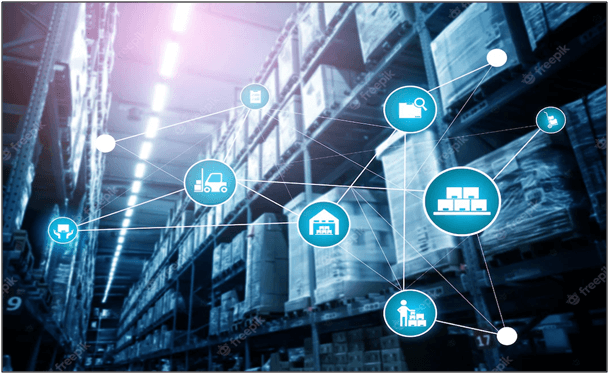Integration of digital technology in the warehouse enhances and transforms traditional warehouse operations by the power of data and technology. It involves the upgrading and automation of manual processes such as inventory management, order fulfilment and shipping. With the emerging technologies in the market companies may utilise the current available technologies or consider the future technologies such as Robotics, the Internet of Things (IoT), Augmented Reality (AR) and more. The integration of digital technology for warehouse management holds immense significance due to its potential to streamline operations, enhance productivity and improve overall customer satisfaction. Traditional manual processes are often time-consuming, prone to error and less adaptable to rapidly changing market demands. Warehouse Management System offers real-time insights of the warehouse processes leading to a data-driven decision-making. This article dives into the types of digital technology that businesses may consider integrating with the Warehouse Management System.

Table of Contents
Warehouse Management System (WMS)
WMS is an essential digital integrator for modern warehouses. The system acts as the central nervous system of the warehouse, organising and optimising various tasks and resources. WMS software is designed to manage, control and monitor warehouse operations. It optimises the routing of pickers, ensuring they take the most efficient path through the warehouse. WMS also prioritizes orders, grouping them by location or other criteria to minimise travel time. Additionally, it provides real-time visibility into order status and inventory levels, helping workers make informed decisions. WMS integrates with various technologies, such as barcode scanners, Radio-Frequency Identification (RFID) systems and even robotics to streamline operations. It helps with inventory tracking, order picking, shipping and receiving. By automating and optimising these processes, warehouses can improve accuracy, reduce errors and enhance overall efficiency.

Internet of Things (IoT)
IoTis the paramount digital technology system used in the warehouse management. There are four components of the IoT System used by industries. The first component is the smart devices and sensors. IoT devices are components that contribute to an intelligent warehouse. The synergy of smart sensors and IoT devices enable to send data to several processing units. The second component is the network connectivity. IoT devices use wired or wireless networks to connect into one system. The network connectivity is responsible in transferring data acquired by IoT devices to a server. The third component is the data processing and storing. By using the processing unit or server to analyse all the data received. It can store data for further usage. The last component is the user interface. This component helps user to access raw data and retrieve information. The data displayed in the form of a dashboard of the required information. The user interface should offer the opportunity to send commands to establish centralised IoT warehouse management.
Barcode Scanners and Radio-Frequency Identification (RFID)
Barcode scanners and RFID technology are essential tools in modern warehouse management, each offering unique advantages. Barcode scanners are fast and accurate, allowing warehouse workers to quickly scan barcodes on products, packages, or shelves. This speeds up processes like inventory management, order picking and shipping. Barcodes are relatively inexpensive to implement. They can be easily printed on labels and attached to products or storage locations. Barcodes minimise human error since they rely on machine-readable codes. This reduces the likelihood of errors in inventory counts and order processing. As for the RFID technology, it provides real-time tracking of items without direct line-of-sight scanning. This enables instant visibility into the location and status of products throughout the warehouse. RFID can automate inventory tracking and management, making it easier to monitor stock levels and trigger reorders when needed. To enhance security, RFID tags has the ability for tracking access to sensitive areas and preventing unauthorized removal of items. Many warehouses use a combination of both technologies to maximize efficiency and accuracy.

Automated Guided Vehicles (AGVs)
Automation is another crucial digital integrator in modern warehouses, and AGVs play a pivotal role in this regard. AGVs are autonomous or semi-autonomous robotic vehicles that are used for material handling within the warehouse. They can transport goods from one location to another without the need for human intervention. AGVs are equipped with various sensors and navigation systems, such as LIDAR (Light Detection and Ranging) and cameras, allowing them to navigate through the warehouse safely. They can transport pallets, bins, or individual items, making them versatile for different warehouse layouts. By integrating AGVs, warehouses can significantly reduce labour costs, increase efficiency and ensure a higher degree of accuracy in material handling.
Robotics and Automation
Robots have become an integral part of warehouse operations, especially in large-scale distribution centres. Robotic Process Automation (RPA) and Autonomous Mobile Robots (AMRs) can automate repetitive tasks such as picking, packing and sorting. These robots can perform a wide range of tasks, from picking and packing to sorting and even autonomous maintenance. One example is the use of robotic arms in order picking. These robots can swiftly and accurately pick items from shelves and place them in order bins. They are guided by computer vision systems, which allow them to identify and grasp objects of various shapes and sizes. Warehouse automation can also include conveyor systems, automated storage and retrieval systems (AS/RS) and robotic palletizers. These technologies help warehouses operate around the clock and handle high volumes of goods efficiently.
The full content is only visible to SIPMM members
Already a member? Please Login to continue reading.

